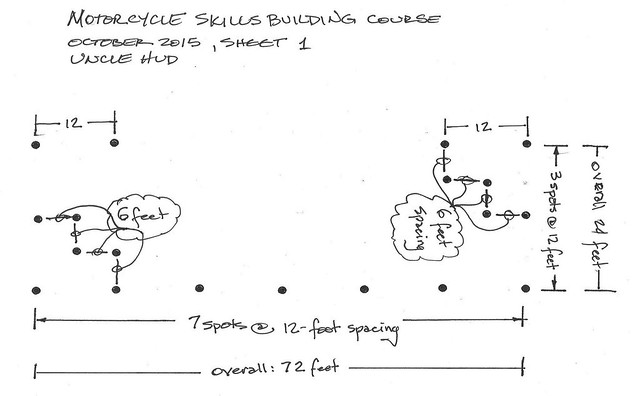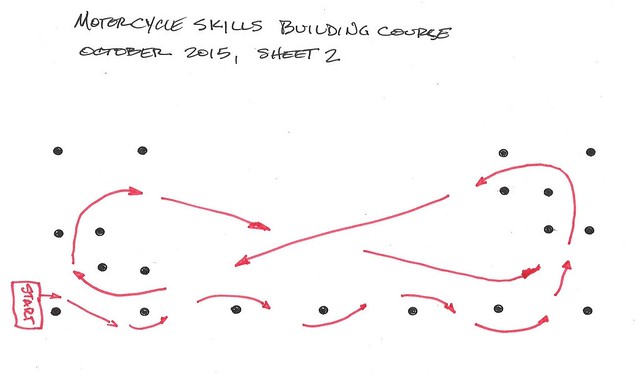Uncle Hud
Just another blob of protoplasm using up your oxyg
When I first got my FJR, I was overwhelmed with how big and heavy she was. Anyone who's seen the scrapes on my bike can attest that I wasn't particularly skilled at slow-speed handling. What did I do about it?
I searched for the DMV motorcycle driving tests, thinking they would provide good practice. Found some diagrams and kept thinking.
Took two sheets of thin cardboard, cut a 3-inch diameter hole in one and a 2-inch diameter hole in the other. Got a can of black spray paint, a can of white, my tape measure, some disposable rubber gloves, and visited the concrete parking deck next door.
Laid out this pattern by first painting big black dots, then painting smaller white dots on top of the black dots. (Asphalt parking lots would probably work better with little black dots on top of big white dots.) The layout was kept squared-up by placing the “weaving” side of the course a foot off the ends of parking space stripes.

I think the reason everything is at 12-foot spacings is because that's the width of a modern highway lane. That means you're practicing your U-turns within the width of a standard two-lane highway. Doing the figure-8 loops provides both left turn and right turn practice.

NOTES:
1. It’s actually a LOT easier to see what you’re supposed to do when you’re driving through the course and looking at the dots.
2. Dunwoody police officers have seen me riding through it a couple of times. I can’t imagine anyone, even the parking deck owner, objecting to this as long as there’s not a gang of bikers congregating around, scaring off customers.
3. I now have a feel for the minimum radius curves I can handle, and the minimum speed I must maintain to keep from “wrestling her to the ground”.
4. It’s also a nice way to warm up the bike and you: run a couple of slaloms and turn a few tight figure-8’s under the morning sun.
5. This practice range is now on the top floor of two or three nearby parking decks. Some have better views of the city than others, which can be awesome on spring mornings. By visiting them all, I avoid concentrating my moto-activity at a single location -- which keeps the entire concept on the down low.
If anyone’s interested, PM me and I can email PDF’s.
I searched for the DMV motorcycle driving tests, thinking they would provide good practice. Found some diagrams and kept thinking.
Took two sheets of thin cardboard, cut a 3-inch diameter hole in one and a 2-inch diameter hole in the other. Got a can of black spray paint, a can of white, my tape measure, some disposable rubber gloves, and visited the concrete parking deck next door.
Laid out this pattern by first painting big black dots, then painting smaller white dots on top of the black dots. (Asphalt parking lots would probably work better with little black dots on top of big white dots.) The layout was kept squared-up by placing the “weaving” side of the course a foot off the ends of parking space stripes.

I think the reason everything is at 12-foot spacings is because that's the width of a modern highway lane. That means you're practicing your U-turns within the width of a standard two-lane highway. Doing the figure-8 loops provides both left turn and right turn practice.

NOTES:
1. It’s actually a LOT easier to see what you’re supposed to do when you’re driving through the course and looking at the dots.
2. Dunwoody police officers have seen me riding through it a couple of times. I can’t imagine anyone, even the parking deck owner, objecting to this as long as there’s not a gang of bikers congregating around, scaring off customers.
3. I now have a feel for the minimum radius curves I can handle, and the minimum speed I must maintain to keep from “wrestling her to the ground”.
4. It’s also a nice way to warm up the bike and you: run a couple of slaloms and turn a few tight figure-8’s under the morning sun.
5. This practice range is now on the top floor of two or three nearby parking decks. Some have better views of the city than others, which can be awesome on spring mornings. By visiting them all, I avoid concentrating my moto-activity at a single location -- which keeps the entire concept on the down low.
If anyone’s interested, PM me and I can email PDF’s.
Last edited by a moderator:




![fjackets Real Lambskin Leather Biker Jacket — Quilted Cafe Racer Zip Up Moto Leather Jackets For Men | [1100085] Johnson Brown, XL](https://m.media-amazon.com/images/I/41I7Pm1f+vL._SL500_.jpg)

























































